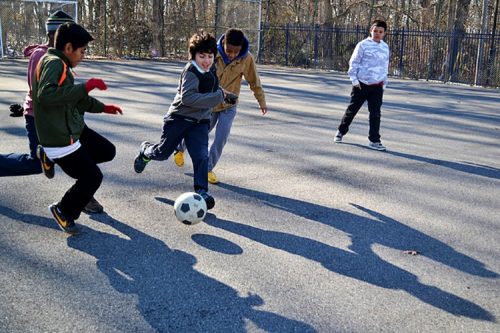Schedule Recess Before Lunch
Better behavior and appetites
Yep, recess before lunch is exactly what it sounds like: Switching the school schedule around so students can play during recess first, then eat lunch. It’s an easy recipe for getting kids to eat healthier and be more alert during class. Research has shown that recess before lunch has lots of positive effects on students’ overall health and wellness, and schools that have adopted the practice report that kids eat more fruits and veggies, drink more milk, waste less food, and are better behaved on the playground and in the classroom.
It makes sense: Students aren’t rushing to eat so they have more time to play, they’ve worked up an appetite to eat all the major food groups, and they’ve burned off excess energy so they’re ready to learn when they go back to class. Win-win-win!
5 Steps to Recess Before Lunch
 Scheduling is often the biggest hurdle to implementing recess before lunch. We’re not going to lie–this one is not going to be easy. You’re going to have to make your case and rely heavily on school administrators to make any substantial changes. But don’t despair: As a parent, there’s still a lot you can do to help the school adopt the recess-before-lunch model. Here are some steps to help you get started:
Scheduling is often the biggest hurdle to implementing recess before lunch. We’re not going to lie–this one is not going to be easy. You’re going to have to make your case and rely heavily on school administrators to make any substantial changes. But don’t despair: As a parent, there’s still a lot you can do to help the school adopt the recess-before-lunch model. Here are some steps to help you get started:
- Build support within the school.
- Research and discuss successful recess-before-lunch programs with school administrators.
- Consider the potential barriers to changing the schedule, and determine ways to rearrange things to move recess before lunch. While the concept sounds simple, policy change requires careful planning and efficient communication.
- Seek teacher and parent input about switching the schedule. Discuss the benefits of the program and the impact it can have both in the classroom and at home.
- Help administrators create a plan to schedule recess before lunch, and gather feedback from school staff, including teachers, lunch monitors and food service workers. Make sure they understand that the initial schedule may need to be revised.
- Help educate school staff and parents on the benefits of recess before lunch. There may be resistance, but remind them of the overall goal of student wellness and improved behavior and learning.
- Get students psyched about recess before lunch. Post flyers and information in the classroom and cafeteria.
- Do a trial run of the new schedule and identify any issues. Principals and other key administrators should spend as much time as possible in the lunchroom during the first few weeks to provide extra support during the transition period and experience any concernsfirsthand.
- Include a hand-washing plan in the schedule. It’s important for food safety, and students should always wash hands before eating, especially during cold and flu season!
- Allow enough time for kids to eat lunch. It’s recommended that they have at least 20 minutes to eat from the time they sit down with their tray.
- Review the schedule after a few weeks. What’s working? What isn’t? Make note of the positive changes and the impact in the classroom. Share results with staff, teachers and parents, and modify the schedule as needed.
Additional Tips
- Patience, patience, patience! Any new program takes time to implement successfully, especially when it impacts scheduling.
- Encourage administrators to get creative and flexible with their planning. Remind all involved that the change is in the best interest of the kids.
- Communicate early and often! Making the change will be so much easier if you get buy-in from teachers and parents early on.
- Kids are more likely to be hungrier and thirstier with lunch being pushed back. Consider helping school staff add a mid-morning snack option.
- Since children will be going straight from the playground to the lunchroom, determine an easily accessible location for cold lunches.
Categories: Physical Activity, PE, & Play